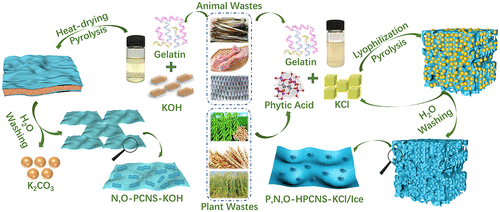当前位置:
X-MOL 学术
›
ACS Appl. Energy Mater.
›
论文详情
Our official English website, www.x-mol.net, welcomes your feedback! (Note: you will need to create a separate account there.)
Sustainable Synthesis of Biomass-Derived Carbon Electrodes with Hybrid Energy-Storage Behaviors for Use in High-Performance Na-Ion Capacitors
ACS Applied Energy Materials ( IF 6.4 ) Pub Date : 2020-01-03 00:00:00 , DOI: 10.1021/acsaem.9b02166 Jin Niu 1 , Jingyu Guan 1 , Meiling Dou 1 , Zhengping Zhang 1 , Jing Kong , Feng Wang 1
ACS Applied Energy Materials ( IF 6.4 ) Pub Date : 2020-01-03 00:00:00 , DOI: 10.1021/acsaem.9b02166 Jin Niu 1 , Jingyu Guan 1 , Meiling Dou 1 , Zhengping Zhang 1 , Jing Kong , Feng Wang 1
Affiliation

|
Although there have been many efforts to improve the performance of electrical energy storage devices by preparing electrode materials with nanostructures and specific chemical compositions, most of the synthetic pathways developed have not addressed issues of safety, cost, and sustainability. Herein, we have simultaneously realized the sustainable synthesis, nanostructure engineering, and heteroatom doping of two carbon materials by separate tailored strategies using gelatin and phytic acid as biomass precursors. These—together with all the other reagents employed—have high terrestrial abundance with low cost and low toxicity and can be easily mixed at a molecular level in deionized water without using organic solvents. Additionally, all the non-carbonaceous products can be easily removed by water washing and further recycled by heat drying. The tailored syntheses result in porous nanosheet structures and uniform heteroatom doping of the final carbons. Based on their typical porosities and chemical compositions, these two carbons have been specifically used as cathode and anode materials in Na-ion capacitors. Electrochemical characterization and first-principles calculations show that the porous nanosheet structures and heteroatom doping endow the carbon electrodes with battery-capacitive storage features, thus leading to their excellent electrochemical performance in half cells. Beneficial from the compatible kinetics of cathode and anode, the assembled Na-ion capacitor exhibits high energy density (135.3 Wh kg–1) and power density (16.1 kW kg–1) as well as ultralong lifetime (88.6% of the initial capacity after 8000 cycles).
中文翻译:

可持续合成具有混合储能特性的生物质碳电极,用于高性能钠离子电容器
尽管已经通过制备具有纳米结构和特定化学组成的电极材料来进行许多努力来改善电能存储设备的性能,但是开发的大多数合成途径仍未解决安全性,成本和可持续性问题。在这里,我们通过明胶和植酸作为生物质前体的单独定制策略,同时实现了两种碳材料的可持续合成,纳米结构工程和杂原子掺杂。这些与所有其他使用的试剂一起具有高陆地丰度,低成本和低毒性,并且可以在分子水平上轻松地在去离子水中混合,而无需使用有机溶剂。另外,所有的非碳质产品都可以通过水洗轻松去除,并通过加热干燥进一步回收。量身定制的合成导致了多孔纳米片结构和最终碳的均匀杂原子掺杂。基于它们的典型孔隙率和化学组成,这两种碳已专门用作Na离子电容器的阴极和阳极材料。电化学表征和第一性原理计算表明,多孔纳米片结构和杂原子掺杂赋予碳电极以电池电容的存储特性,从而使其在半电池中具有出色的电化学性能。受益于阴极和阳极的相容动力学,组装的Na离子电容器表现出高能量密度(135.3 Wh kg 这两种碳已专门用作Na离子电容器的阴极和阳极材料。电化学表征和第一性原理计算表明,多孔纳米片结构和杂原子掺杂赋予碳电极以电池电容的存储特性,从而使其在半电池中具有出色的电化学性能。受益于阴极和阳极的相容动力学,组装的Na离子电容器表现出高能量密度(135.3 Wh kg 这两种碳已专门用作Na离子电容器的阴极和阳极材料。电化学表征和第一性原理计算表明,多孔纳米片结构和杂原子掺杂赋予碳电极以电池电容的存储特性,从而使其在半电池中具有出色的电化学性能。受益于阴极和阳极的相容动力学,组装的Na离子电容器表现出高能量密度(135.3 Wh kg 因此,它们在半电池中具有出色的电化学性能。受益于阴极和阳极的相容动力学,组装的Na离子电容器表现出高能量密度(135.3 Wh kg 因此,它们在半电池中具有出色的电化学性能。受益于阴极和阳极的相容动力学,组装的Na离子电容器表现出高能量密度(135.3 Wh kg–1)和功率密度(16.1 kW kg –1)以及超长寿命(8000次循环后初始容量的88.6%)。
更新日期:2020-01-03
中文翻译:

可持续合成具有混合储能特性的生物质碳电极,用于高性能钠离子电容器
尽管已经通过制备具有纳米结构和特定化学组成的电极材料来进行许多努力来改善电能存储设备的性能,但是开发的大多数合成途径仍未解决安全性,成本和可持续性问题。在这里,我们通过明胶和植酸作为生物质前体的单独定制策略,同时实现了两种碳材料的可持续合成,纳米结构工程和杂原子掺杂。这些与所有其他使用的试剂一起具有高陆地丰度,低成本和低毒性,并且可以在分子水平上轻松地在去离子水中混合,而无需使用有机溶剂。另外,所有的非碳质产品都可以通过水洗轻松去除,并通过加热干燥进一步回收。量身定制的合成导致了多孔纳米片结构和最终碳的均匀杂原子掺杂。基于它们的典型孔隙率和化学组成,这两种碳已专门用作Na离子电容器的阴极和阳极材料。电化学表征和第一性原理计算表明,多孔纳米片结构和杂原子掺杂赋予碳电极以电池电容的存储特性,从而使其在半电池中具有出色的电化学性能。受益于阴极和阳极的相容动力学,组装的Na离子电容器表现出高能量密度(135.3 Wh kg 这两种碳已专门用作Na离子电容器的阴极和阳极材料。电化学表征和第一性原理计算表明,多孔纳米片结构和杂原子掺杂赋予碳电极以电池电容的存储特性,从而使其在半电池中具有出色的电化学性能。受益于阴极和阳极的相容动力学,组装的Na离子电容器表现出高能量密度(135.3 Wh kg 这两种碳已专门用作Na离子电容器的阴极和阳极材料。电化学表征和第一性原理计算表明,多孔纳米片结构和杂原子掺杂赋予碳电极以电池电容的存储特性,从而使其在半电池中具有出色的电化学性能。受益于阴极和阳极的相容动力学,组装的Na离子电容器表现出高能量密度(135.3 Wh kg 因此,它们在半电池中具有出色的电化学性能。受益于阴极和阳极的相容动力学,组装的Na离子电容器表现出高能量密度(135.3 Wh kg 因此,它们在半电池中具有出色的电化学性能。受益于阴极和阳极的相容动力学,组装的Na离子电容器表现出高能量密度(135.3 Wh kg–1)和功率密度(16.1 kW kg –1)以及超长寿命(8000次循环后初始容量的88.6%)。


























 京公网安备 11010802027423号
京公网安备 11010802027423号